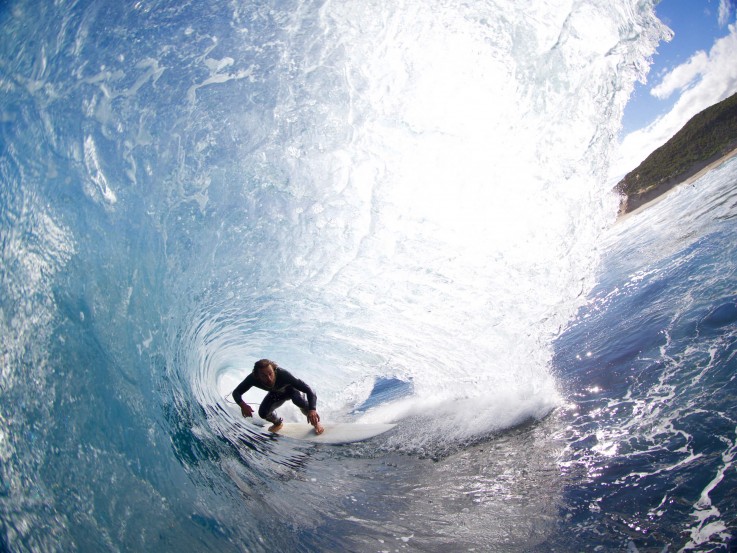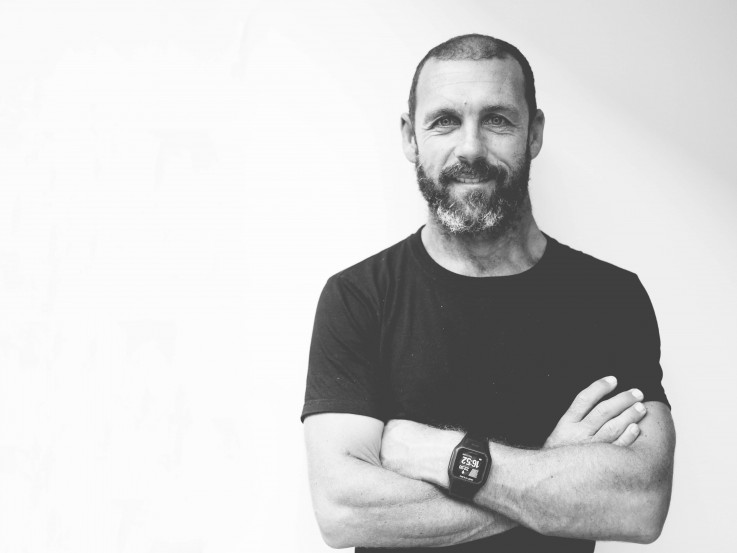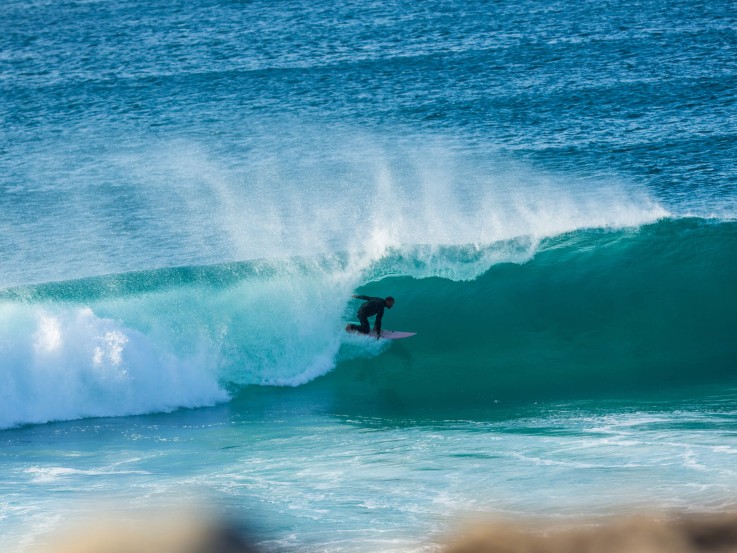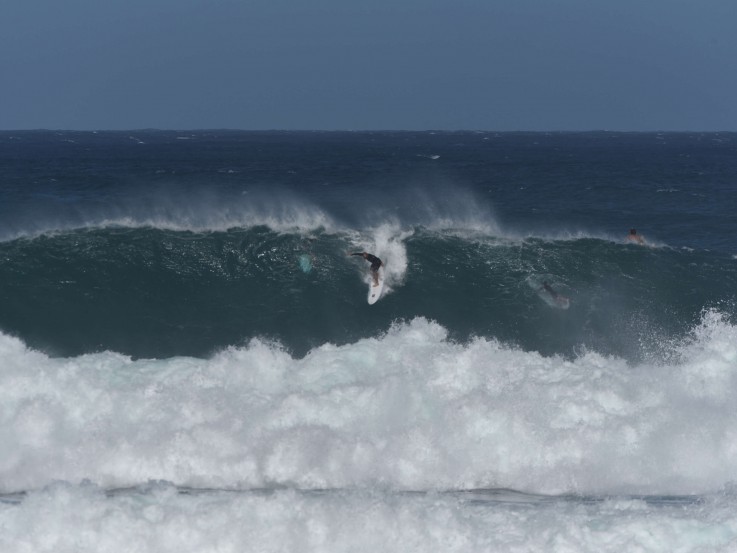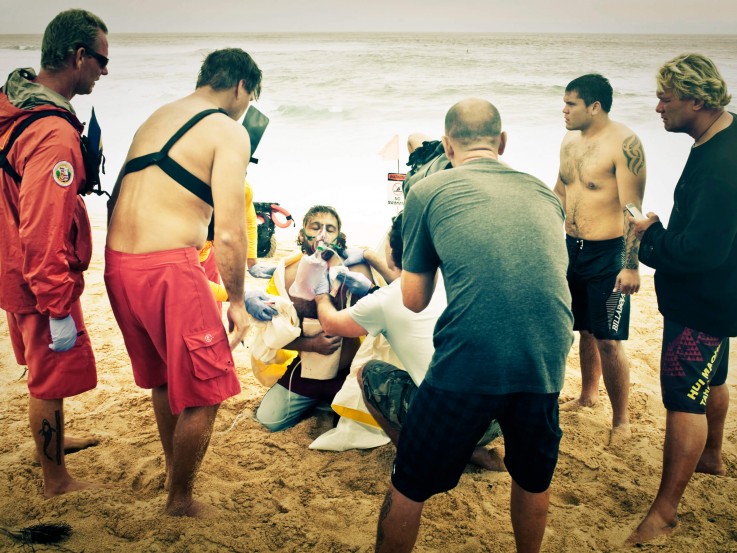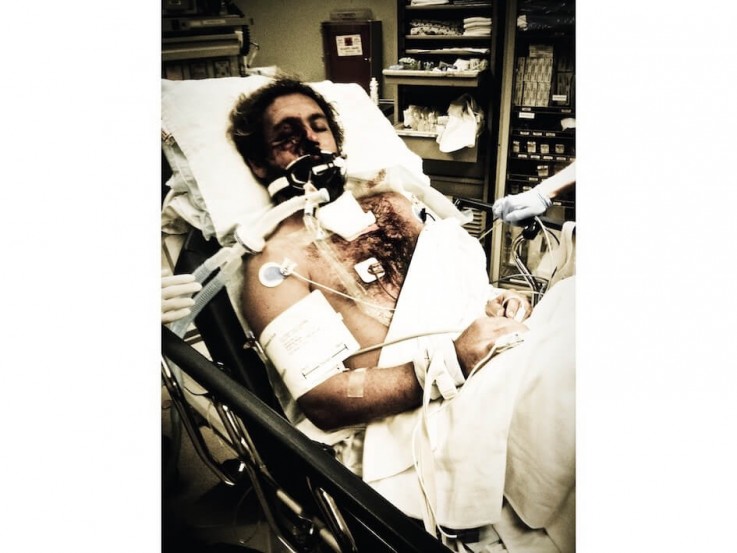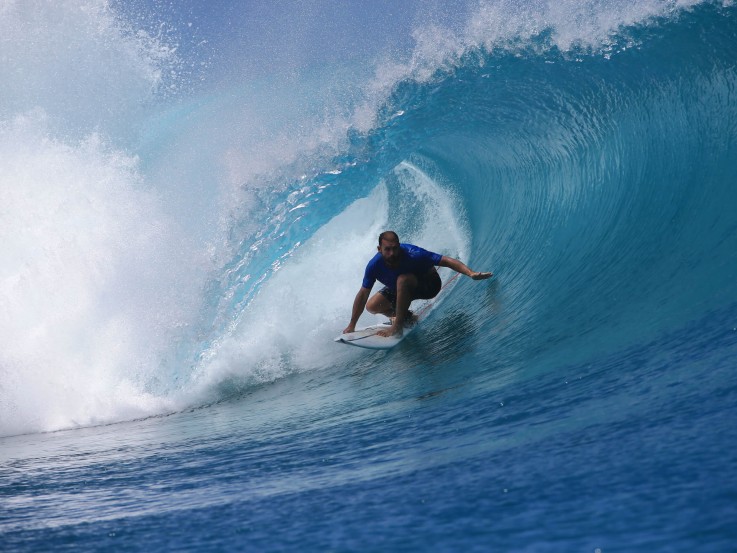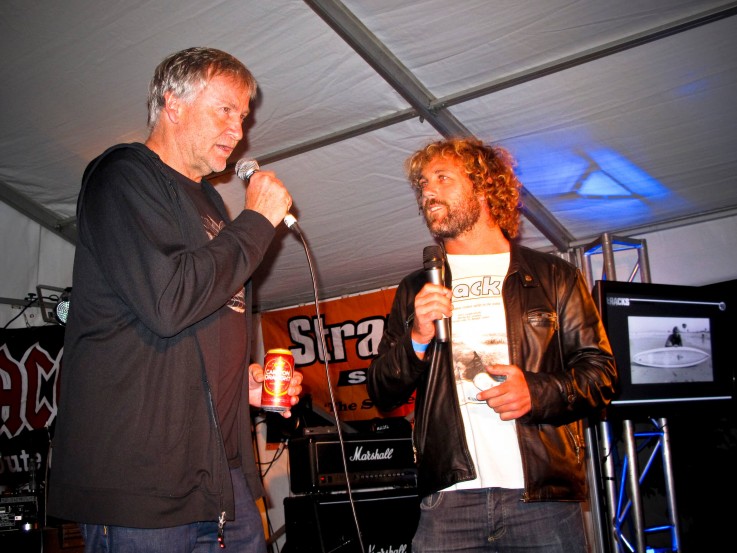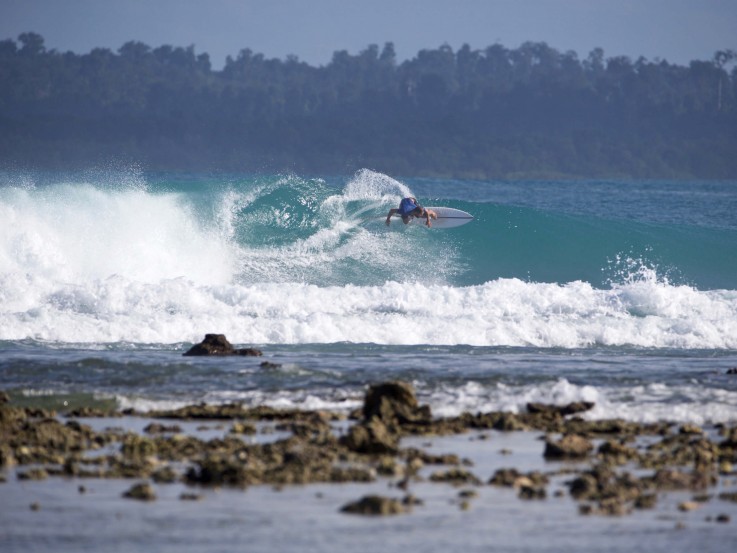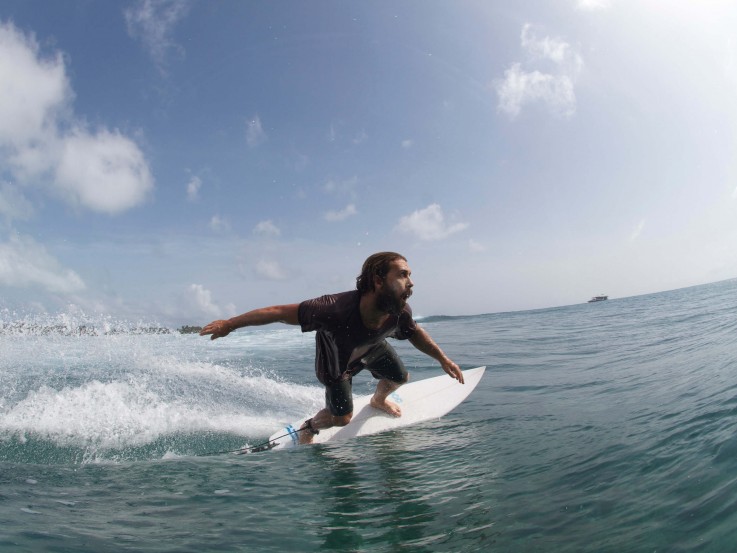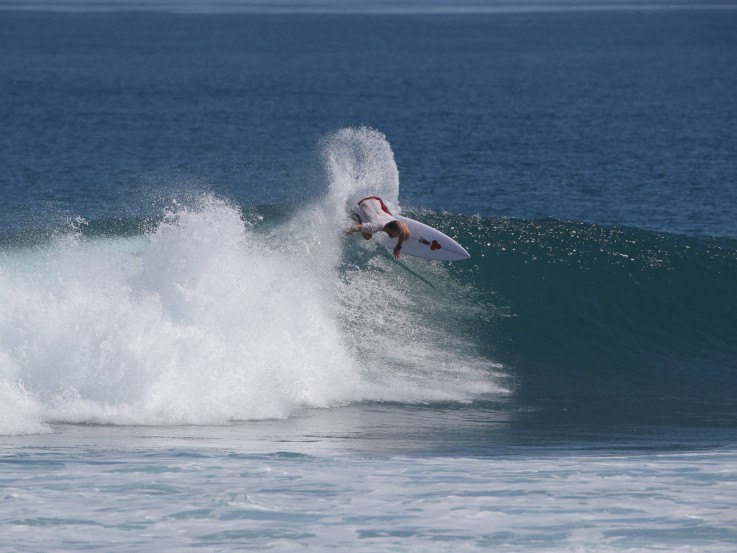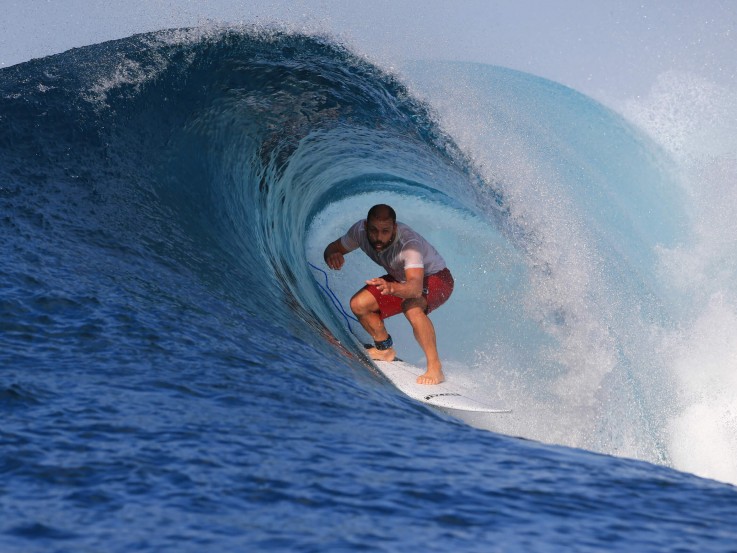Luke Kennedy - Editor of Tracks Magazine
In a time where the beloved surf mag is feeling the pinch of the financial pressures delivered by the digital age, a few publications have held strong against the changing tides of surf media. The iconic TRACKS, a magazine that has been running since the 70’s, has remained a household name among Australia’s rich surf culture and beyond.
Steering the publication through the sometimes murky and turbulent waters of today’s media climate, is Bondi-raised Luke Kennedy. A passionate surfer and lover of the written word, Luke is known for being partially amphibian given the amount of time he spends in the water, and possessing a gravelly voice thanks to a ripped open windpipe at the North Shore’s Sunset Beach. He lives and breathes the sport, as much as any of the colourful characters populating TRACKS’ well-thumbed pages.
Acutely intelligent and quietly observant, Luke’s vision is an ongoing testament to the continued success of TRACKS. Poured over by frothing surf groms and salty old sea dogs alike, the former with their sights set on the fame of the CT or the enviable lifestyles of the top freesurfers, and the latter, with their heads and stories still rooted in the good old days.
Succeeding prolific surf journalist and author Sean Doherty in the Editors chair, Luke now holds the baton for longest standing in the position, ten years. With a poetic, and often humorous writing style, intermingled with surfing subculture’s unique and often vibrant language, Luke eloquently portrays its multitude of unique personalities. His storytelling is peppered with generous amounts of nostalgia while keeping his eyes firmly forward on the progression of surfing and it’s ever evolving culture. So without further ado, meet Luke, the man at the head of what truly is “The Surfers’ Bible”.
Let’s start at the beginning. Where are you from, and where do you call home now?
I was born in Sydney’s eastern suburbs and then we spent four years at Mermaid Beach on the Gold Coast when I was between the ages of four and eight. That’s when I got my first taste of surfing. I have lived in and around Bondi since I was eight.
As a surfer growing up on the busy surf beach Bondi, did you have any future aspirations of working in the surf industry?
I dreamed of any job that would give me the freedom to go surfing and immerse myself in surf culture. From a young age I would read Tracks cover to cover, so there was always a sense that perhaps that was the direction I was heading in.
How did you land one of the most coveted positions in surf journalism, as the Editor of iconic surf mag Tracks, a position you have now held for the best part of a decade?
When I was at university I submitted articles to Tracks. I didn’t really wait for an invitation; I just tried to come up with relevant story ideas and craft them in accordance with the magazine’s tone. I wrote about everything from surf trips with my Mum to stopping a rail line on Bondi Beach. Not everything I submitted was published but a number of things were and when a vacancy came up for the deputy editor’s role I was asked to apply. I got the job and fortunately I had the opportunity to work and learn alongside then editor, Sean Doherty. Sean’s extremely bright, incredibly hard working and probably unrivalled when it comes to passion for all aspects of surf culture. When Sean vacated the editor’s chair back in 2008 I applied and have been in the role ever since.
What are some of the challenges you have faced, steering this publication through the changing tides of print journalism, navigating the desires for instant gratification in the digital age?
The first major challenge is human resources. It’s theoretically possible to produce a great magazine and have a website that really hums (along with other social media channels) but it requires a major investment of resources and funds. Ultimately what happens is you end up wearing a lot of different hats and dividing your energy between the magazine, the website and instagram posts etc. The other major challenge is to really define how one medium is different from another. What content and aesthetic qualities should be on a website vs what appears in the magazine. Where is there scope for them to overlap?
What did you do before your career in surf journalism kicked off?
I worked as a casual school teacher.
Are those infamous, almost clichéd, issue deadline days really as stressful as we all imagine they might be?
Yes, they are pretty full on. Often you are still producing content right up until the final minute, while simultaneously trying to check everything else and ensure that each page, each caption, each photo is the best it can be. The come down on the other side is pretty good though, knowing you have worked hard to get something out and have a brief window in which to relax and contemplate the possibilities.
Do you have a favourite issue, or a story or photo that landed in your lap that sticks out in your memory?
Probably travelling through the USA for the ‘Tracks across America’ issue back in 2011. The atmosphere in New York was incredible. I’ll never forget being on the beach as a still-dripping Kelly was about to receive his runner-up trophy at the Quiksilver Pro. As the MC handed him the mic there was a moment’s hush and someone in the crowd (20 000 people) screamed out, “Hey Kelly is that a sock in your suit or are you just happy to see us?” It was a classic moment. The same trip I met Arnold Schwarzenegger in the lobby of the hotel I was staying at in Santa Monica California. I also had a wild time hanging out with surfing legend, David Nuuhiwa, in San Clemente. Kelly and I even traded a few stories and drinks the night he won the event at Trestles – after his rematch with Owen Wright. I’d heard he was upset because I’d been referencing his lack of hair in blogs, so I approached him about it. We ended up having a good chat. It was one of those trips when everything kind of came together. Even getting stuck in traffic behind Obama’s cavalcade in California, the day I was leaving.
With the recent release of confronting documentary, ‘Andy Irons: Kissed by God’, detailing his life and tragic death, surfing’s own “A.I” has been making headlines again. What was it like to be on the front lines of one of the biggest stories to break the surf industry in the last 10 years?
I’d be lying if I said I was at the front-line. I wasn’t in Puerto Rico at the time. However, I think it was a huge wake-up call for surfing. The industry and the culture had always been a place for keeping up appearances, never dropping your guard and presenting an image of perfection. It’s sad that it took Andy’s death to do it, but I think surfers in general (not just professionals or industry insiders) feel more at liberty to open up and discuss what’s going on for them – particularly since the release of the documentary. The real heroine in the whole story is Lindy Irons who was instrumental in making the film and then travelled around the world to the premieres to help ensure the message got out there. It’s easy to say, but it was incredibly brave on her behalf.
I’m sure you are looking at epic surf shots, all day, every day, with particular importance paid to the cover shot. Is there a photographer you really love, one that just delivers those magic images over and over again?
Ahh. I have too many favourites. I love the images but to be honest it’s the personalities of the photographers, which often intrigue me and make me smile. It’s such a challenging art form. To get into those situations where you create an iconic image and align yourself with the world’s best surfers you have to be a pretty unique individual. They have to be tuned into every quirk of the ocean and the surfers. They are like alchemists trying to summon all the right elements to capture a fleeting moment of perfection. It makes them interesting people because they are attuned to a set variables very different to the average jimmy or jenny.
You must have been sent on some pretty epic press trips in your time, any stand outs?
Hawaii is always special, even though I nearly died at Sunset. The first work trip to G-land with Tom Carroll, Jim Banks and Joel Fitzgerald still stands out.
They were all big personalities in different ways. The waves fired and the whole place has a magical vibe with the reef and the jungle. Tom Carroll is probably one of the most entertaining humans to be around. He’ll get up and dance with the traditional Indonesian dancers, ride waves like a pro twenty years his junior, tell classic stories, take his own photos and talk to anyone.
The CT has changed a lot over the last decade, the surfers, the governing body and the professionalism of industry itself. Do you have a favourite event, past or present? What do you think about the current CT schedule, particularly the introduction of Kelly Slaters wave pool?
I love the Australian, east coast events because Torquay, Coolangatta and Newcastle (WQS) really embrace the arrival of the world’s best surfers. The Pipe Masters is however the one contest every fan should try and get to. Even the free surfing at Pipe and Off the Wall has a different level of intensity. Surfing is a part of the culture at other locations but in Hawaii, on the Nth shore, surfing is the primary reason for being. Kelly’s wave pool is great for one event, but that’s it.
What is the best part of your job and what are some of the biggest challenges you face?
The best part of the job is writing a story that I’m really satisfied with and pulling together a magazine that I think people will enjoy – something that will help reaffirm their love of surfing. The biggest challenge is information overload.
What advice would you give to aspiring writers and photographers, looking to jam a foot into the hyper competitive surf industry’s door?
You have to really study the best writing and photos in the mags. That’s where the best of all mediums resides most of the time. Being able to write a good story or take a good photo (or both) is at the core of surf media. If you can do that, the skills can be applied to the other mediums.
So, turning the story spotlight your way, tell us about your near death experience at Sunset and the effect such a traumatic, yet lucky, experience had on you afterwards?
It was my first day in Hawaii (second ever trip) and I got carried away with the moment. Sunset was eight foot and fun, Tom Curren was out there. Occy was out there. A bunch of other pros were in the water and I stayed out too long. Ultimately I was fatigued when I came in and I lost my board duck-diving an ugly double-up right on shore. It’s often said but you don’t know power until you’ve felt it in Hawaii. The board was wrenched from my grip and punctured my trachea under the water (probably the nose). I popped up and was breathing through a hole in my neck.
Ross Clarke-Jones was in rescue mode on the beach then a trauma surgeon happened to jog by and buried his fingers knuckle deep in the hole to make sure my carotid artery and jugular vein weren’t severed. Long story short I was lucky to survive. To be honest, I’ve loved surfing more than ever since that happened. My breathing is somewhat more limited now but I still go back to Hawaii and Sunset.
[Scroll down for the video clip capturing the result of the accident in gory detail]
Get to know you:
What are you known for?
Surfing too much.
What are you most proud of?
A public speaking competition I won at school. My Bondi Boardriders title.
Who or what is your greatest inspiration?
My mum. She encouraged me to get an education and made a lot of sacrifices.
If you could spend a day with someone who inspires you, who would it be and what would you do?
I’d like to go back in time and meet John Steinbeck and pick his brain for writing secrets.
If you could be someone else for a day, who would it be?
I’d be John John at Pipe – just to know what it’s like to ride a wave like that with confidence and go deep.
Defining moment?
Repeating the fifth grade. I went from the dumb kid to doing ok.
Guilty pleasure?
Cryptic Crosswords instead of work.
What is the most important thing you have learned in your life?
There is so much good in the worst of us, so much bad in the best of us and very little that can be said by any of us about the rest of us. Not my line by the way.
Of all the places you have travelled to, what place in particular stands out? And why?
Hawaii – it’s where you live, sleep, breathe surf. If I don’t go I start to have vivid daydreams about it.
What brings you the most happiness in the world?
A morning surf, a good coffee and a few laughs with my girlfriend.
What are you most grateful for?
The existence of surfboards.
Surf talk:
When and how did your passion for surfing start?
Six or Seven with my dad pushing me into a couple on his pink, sky twin fin.
What does surfing mean to you, and how has it changed your life?
If you don’t surf you never did. Think about it. It hasn’t changed it, it’s saved it, a few times and maybe almost taken it away a couple too.
Favourite wave?
K-Bay around the corner from Bondi.
Most memorable session?
The one I had about half an hour ago. Always the most memorable.
Favourite surfer?
Tom Curren
Most hardcore surf spot you've visited?
Gnaraloo – hardest wave I’ve ever surfed. Sorry I couldn’t drive the manual Russ (Ord)
Favourite board?
Right now it’s a 5’7” twin fin with stabilizer by PCC.
Finish the sentences:
I love…
… reading.
I miss…
… the 80s.
I wish…
… I had my own jet airplane.
I want…
… to surf till the day I die.
Where can we find you online?
I’d rather be reading a book or doing a crossword.
| Instagram: | @bubba_kennedy |
Not for the fainthearted or squeamish:
Posted by: Emma Gibbons, on November 21, 2018
Categories: Interviews
Latest Posts
Craig Sims - White Horses & Surfing Life Publisher
Luke Kennedy - Editor of Tracks Magazine
Simon ‘Swilly’ Williams - Surf Photographer
Jarra Campbell - the Bondi Alchemist
Greg Gordon - Owner of CR Surf
Shayne Nienaber - Surf Photographer
Alexa Hohenberg - Owner of Still Stoked
Christine Deveney - TapaReef Owner & Creator
Russell Ord - Surf Photographer
Richard Kotch - Surf Photographer
Categories
Interviews
Articles
Videos
Press Releases
Quiz
Archive
December 2018
November 2018
October 2018
September 2018
August 2018
July 2018
June 2018
May 2018
April 2018
March 2018
February 2018
January 2018
November 2017
January 2017
December 2016
November 2016
October 2016
September 2016
August 2016
July 2016
June 2016
May 2016
April 2016
March 2016
February 2016
January 2016
December 2015
November 2015
October 2015
September 2015
August 2015
July 2015
June 2015
May 2015
April 2015
March 2015
February 2015
January 2015
December 2014
November 2014
October 2014
September 2014
August 2014
July 2014
June 2014
May 2014
April 2014
March 2014
February 2014
January 2014
December 2013
November 2013
October 2013
September 2013
August 2013
July 2013
June 2013
May 2013
April 2013
March 2013

